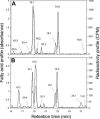Dependence of arbuscular-mycorrhizal fungi on their plant host for palmitic acid synthesis
- PMID: 16151123
- PMCID: PMC1214663
- DOI: 10.1128/AEM.71.9.5341-5347.2005
Dependence of arbuscular-mycorrhizal fungi on their plant host for palmitic acid synthesis
Abstract
Lipids are the major form of carbon storage in arbuscular-mycorrhizal fungi. We studied fatty acid synthesis by Glomus intraradices and Gigaspora rosea. [(14)C]Acetate and [(14)C]sucrose were incorporated into a synthetic culture medium to test fatty acid synthetic ability in germinating spores (G. intraradices and G. rosea), mycorrhized carrot roots, and extraradical fungal mycelium (G. intraradices). Germinating spores and extraradical hyphae could not synthesize 16-carbon fatty acids but could elongate and desaturate fatty acids already present. The growth stimulation of germinating spores by root exudates did not stimulate fatty acid synthesis. 16-Carbon fatty acids (16:0 and 16:1) were synthesized only by the fungi in the mycorrhized roots. Our data strongly suggest that the fatty acid synthase activity of arbuscular-mycorrhizal fungi is expressed exclusively in the intraradical mycelium and indicate that fatty acid metabolism may play a major role in the obligate biotrophism of arbuscular-mycorrhizal fungi.
Figures





References
-
- Amijee, F., and P. Stribley. 1987. Soluble carbohydrates of vesicular-arbuscular mycorrhizal fungi. Mycologist 21:20-21.
-
- Bago, B., and G. Bécard. 2002. Bases of the obligate biotrophy of arbuscular mycorhizal fungi, p. 33-48. In Gianinazzi, S. H. Schüepp, J. M. Barea, and K. Haselwandter (ed.), Mycorrhizal technology in agriculture. Birkhäuser Verlag, Basel, Switzerland.
Publication types
MeSH terms
Substances
LinkOut - more resources
Full Text Sources
Medical

